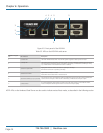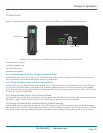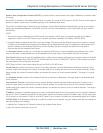
724-746-5500 | blackbox.com
Page 52
724-746-5500 | blackbox.com
Chapter 8: Listing/Descriptions of Hardened Serial Server Settings
The model number of the currently selected Hardened Serial Server is displayed on the Login page of Serial Server Software.
Network Protocols available for use on Hardened Serial Servers (LES421A, LES422A, and LES424A) include TCP, UDP, VCOM,
and Paired Mode.
Network Watchdog controls the duration of network inactivity when a network connection is determined idle and causes the
connection to be forced closed. The range is 1 through 65535 milliseconds.
Paired Mode enables two Hardened Serial Servers to operate across the network like a “wire replacement” between two serial
devices. (Paired Mode is also called serial tunneling.) Serial devices connected to Hardened Serial Servers on each end of the link
can communicate as if they were connected by a serial cable.
• For Paired Mode to work, one Hardened Serial Server must be configured as a TCP server and the other as a TCP client.
• The Hardened Serial Server configured as the TCP client initiates connections. You must set up the IP address and port number
of the server that you want the client (Hardened Serial Server) to communicate with. You also select whether you want the
Hardened Serial Server to connect at power up or only when it receives data from the device connected to its serial port.
• The Hardened Serial Server configured as a TCP server waits for connections to be initiated by another network device. You
must set up the TCP port number on which it will listen for connections and set the maximum (one, up to two, or up to four)
number of simultaneous connections it will accept. You can filter the connections it will accept based on specific IP addresses or
ranges of IP addresses that you specify.
Password. When you first receive the LES421A, LES422A, or LES424A Hardened Serial Server from the factory, the password is
blank so that you can initially access the Hardened Serial Server without entering a value into this field. To ensure security, you
should create and save a password the first time you configure the serial server. After a password has been set up it must be
entered each time you login to Hardened Serial Server Software. The password is used to access the configuration pages from the
Hardened Serial Server Software Login page and can be changed from the General page.
Serial Interface Modes. Four serial interface modes of operation are:
• RS-232—Point-to-point serial communications connection used by PC COM ports and many other systems. Capable of baud
rates up to 115.2 kbaud over short distances (about 50 feet). Typically uses DB9 connectors, but a 5-screw terminal block can
also be used on LES421A serial servers.
• R S - 4 2 2 —Point-to-point communications using a transmit pair and a receive pair. RS-422 can operate at higher speeds and
longer distances than RS-232. Typically uses two shielded twisted pairs and screw terminals but DB9 connectors are used on
LES421A, LES422A, and LES424A serial servers.
• RS-485 2-wire—Similar speed and distance specifications as RS-422, but allows multidrop connections. Typically uses one
shielded twisted pair and screw terminals but DB9 connectors are used on LES421A, LES422A, and LES424A serial servers.
• RS-485 4-wire—Similar speed and distance specifications as RS-422 but allows full-duplex connections. Typically uses two
shielded twisted pairs and screw terminals but DB9 connectors are used on LES421A, LES422A, and LES424A serial servers.
Select the appropriate serial interface mode for the type of connection between the Hardened Serial Server’s serial port and the
device connected to it.
NOTE: Refer to Appendix B for connector and pinout details.
Hardened Serial Server Name is a unique name assigned to the serial server. It must be a valid hostname as defined by
RFC-952 and RFC-1123. The rules are:
• It must consist only of the characters “A” to “Z,” “a” to “z,” “0” to “9,” or “-”
• It can start or end with a letter or a number, but it must not start or end with a “-”
• It must not consist of all numeric values.
The Server Serial Port Number of the currently selected port is shown in this field. For more information, refer to the TCP/UDP
Ports table in Section 1.4, which shows the ports used for several modes of operation.


















